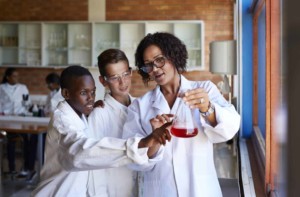4 Tips to Graduate College-and-Career-Ready Students

By: Katie McClarty
We live in an exciting time, when previously disconnected information regarding student achievement and social wellbeing can be used in innovative ways to predict and measure student outcomes. This provides new opportunities to positively impact student outcomes by monitoring key predictors from an early age, identifying at-risk students, and developing appropriate interventions and measurements to help them along the path toward college and career readiness.
At Pearson’s Center for College & Career Success, we work to identify and measure the skills needed for students to be successful in college and careers, determine pathways for students to be ready, track progress along the pathway, and evaluate effective ways to keep students on track. The following tips derive from our experiences in this pursuit and can serve as a guideline for educators who wish to prepare students at all levels for success in college and beyond:
Early Detection and Intervention are Key
Students have a long educational journey, and many things happen between the first day of kindergarten and high school graduation. Rather than focus all our predictions on that distant time point, however, we recommend dividing the educational timeframe into smaller increments that can be more readily assessed and addressed. Educators should look at elementary predictors of middle school success, middle school predictors of high school success, and high school predictors of college success. At every level, we can identify indications that a student is off track and work to get them realigned. This creates a progression of oversight aiming to get all students on track toward eventual college readiness from the very beginning, and that measures time in small enough increments to easily track progress, measure the influence of any interventions, and redirect course if necessary.
The earlier we can detect telltale signs of students veering off course, the better. According to the ACT report, Catching Up to College and Career Readiness, eighth-grade students who were far behind had difficultly catching up by twelfth grade. For example, only three percent reached the ACT college readiness benchmark in mathematics. The results looked slightly better for students who were off track in fourth grade. Four years later, 10 percent of these students reached the college readiness benchmark in mathematics on ACT’s EXPLORE test, implying that it may be easier to catch up in mathematics at earlier grades.
Dropout Prevention is Just the Beginning
While both useful and important, focusing on dropout prevention alone is not the same as focusing on college readiness—as graduation itself does not equal college preparedness. Our national graduation rate has just topped 80 percent, but not all of these students are college-ready or career-ready. In fact, 60 percent of community college students need to enroll in developmental education according to the Community College Research Center at Columbia University.
There is a Broad Range of Predictive Factors
When attempting to identify at-risk students, most schools focus on the ABC’s—attendance, behavior and course performance. These measures are certainly important and are a good start toward predicting graduation and even college readiness. However, at Pearson’s Center for College & Career Success, we have found that there are other important factors to consider.
We used a national dataset to predict college readiness (as measured by high school grades and admissions test scores) in eighth grade. We organized the predictors into six categories: academic achievement, behavior, motivation, social engagement, school characteristics, and family circumstances. Achievement, as expected, was found to be the most predictive. However, motivation and behavior were also significant factors and, together, contributed more than achievement alone. This expands targets for interventions; tardiness, time spent on homework, and students’ college or career goals are additional factors that can be monitored and adjusted as needed.
Technology can Provide a Holistic Picture of Student Readiness
Rather than looking at separate risk thresholds for attendance, behavior, or course performance, our ultimate goal is to create a more holistic picture of student readiness by assessing a greater number of contributing factors in tandem. In addition to the ABCs, the emergence of digital curricula and activities could allow schools to automatically track factors such as time spent on homework and incomplete assignments, which our research suggests are important predictors of success. By integrating multiple sources of data, schools can identify a wider range of issues more quickly and then create individualized programs to get students back on track.
As problems are identified and addressed, the same data can help track student response to interventions and inform teachers, students, and parents of progress. The key is being able to integrate data systems so schools can assess readiness on an ongoing basis and communicate back to all parties in a timely manner.
The path toward college and career readiness will continue to change shape as new types of data and analyses become available to facilitate student achievement and future success. By looking for early predictors centered on smaller time increments, focusing efforts on the right factors and interventions, and incorporating technology for advanced analysis, educators can provide optimal environments for making students career and college ready.
We are excited to keep this conversation going- watch for the next Smart Series paper to launch next week, College and Career Readiness GPS for Every Student.
Katie McClarty is Director of the Center for College & Career Success in Pearson’s Research & Innovation Network. She leads a team of researchers in planning and executing research in support of the Center mission, which is to (1) identify and measure the skills needed to be successful in college and careers, (2) determine pathways for students to be college and career ready, (3) track their progress along the pathway, and (4) evaluate effective ways to keep students on track. Dr. McClarty holds a doctorate degree in social and personality psychology from the University of Texas at Austin.






0 Comments
Leave a Comment
Your email address will not be published. All fields are required.